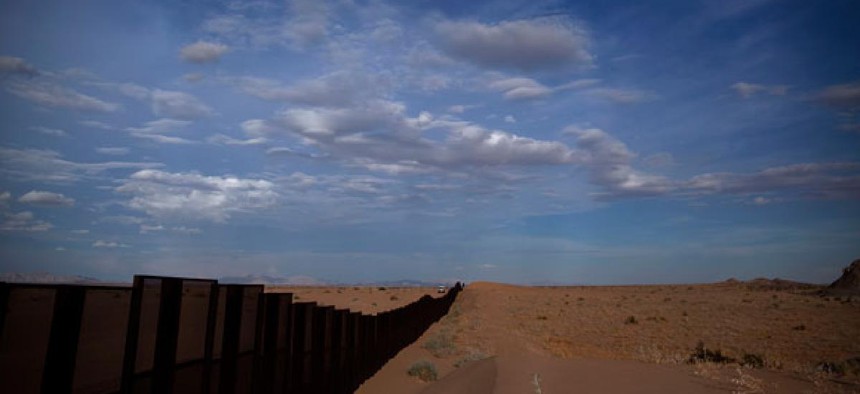
Guillermo Arias/AP file photo
The Border Hawks Have Already Won
Senate immigration bill addresses hard-liners' concerns, giving them less reason to oppose the final product.
Questioning the security of the border, a go-to tactic for the forces seeking to derail immigration reform, has lost some of its punch. The Homeland Security Department has spent the past decade implementing recommendations from border-security hawks—adding fencing and ground agents, as well as beefing up intelligence along the U.S.-Mexico border. Immigration legislation pending in the Senate would provide an additional $5 billion for enforcement and require the Border Patrol to successfully stop 90 percent of the people who try to cross illegally. Taken together, it’s hard to say the federal government isn’t doing enough.
That’s potentially significant. The two schools of thought on how to fix immigration—“border security first” versus “comprehensive reform”—have been at a stalemate in Congress ever since a sweeping immigration bill died in the Senate in 2007. The Republican-led House reacted angrily to the comprehensive measure introduced by Sens. John McCain, R-Ariz., and Edward Kennedy, D-Mass., in 2005. House GOP leaders opted for border security first and muscled through a tough enforcement bill that called for 700 miles of fencing. That measure never became law, but the fence went up anyway.
The “Gang of Eight” Senate bill illustrates the sway the security hawks have held. Take that ambitious 90 percent benchmark. Homeland Security officials say they should be able to meet it, even though the apprehension rate is now closer to 60 percent. There is, however, a catch. They warn that such a vast enhancement cannot occur without other changes that secure-the-border advocates generally oppose. Administration officials say a new work-visa program would give foreign job seekers a legitimate way into the country, reducing illegal border crossings to a more manageable crew of drug traffickers. Legalization for noncriminal undocumented immigrants would allow authorities to focus on the deliberately exploitative sweatshops rather than sifting through millions of employment-verification forms of well-meaning businesses.
The advances in security make border skeptics less virulent this time around, even though the current Senate bill follows the same model as the McCain-Kennedy measure. The related critiques these days are sophisticated, constructive suggestions about surveillance. “We have the technology that we can do that. The question is whether or not we utilize it, and they are not very effective at implementing technology,” said Sen. Tom Coburn of Oklahoma, the top Republican on the Senate Homeland Security and Governmental Affairs Committee.
Some examples of practical changes suggested by the committee: 1) Outfit all the single-engine airplanes in the Border Patrol’s fleet with infrared camera systems; 2) Give border agents handheld devices that allow them to see in the dark; 3) Establish ground-control stations for each of the Border Patrol’s unmanned aerial-surveillance vehicles.
All of those improvements are on DHS’s To Do list, regardless. “We’re going to have a lot of money. You’re going to get this money,” Homeland Security Committee Chairman Thomas Carper, D-Del., assured department officials at a hearing this week. “Part of our responsibility is to find out how we make you better.”
Two major enforcement mandates in the Senate’s immigration bill could cause DHS some difficulty, but border-security hawks have no coherent way to argue against them. The legislation calls for a system to track legal immigrants who exit the country, a recommendation that dates back to the 9/11 commission. And the bill would require all employers to sign up for the government’s electronic verification system, called E-Verify, to check the status of hires.
From a political perspective, it strains credulity for opponents of the bill to protest these provisions after having doggedly advocated for them. Rep. Lamar Smith, R-Texas, for example, has tried for years to get the House to pass his mandatory E-Verify bill. Reacting to the enforcement provisions of the Senate’s comprehensive bill, Smith now complains that the benchmarks lack deadlines. That’s an argument for a tweak, not a wholesale rewrite.
From a practical perspective, a sizable chunk of the most-needed border enhancements boil down to upgrading the government’s information technology. That’s not a hard imbalance to correct in writing legislation. “We have overinvested in the front end on Border Patrol agents and underinvested in the IT systems at the back end,” said Stewart Verdery, who was in charge of immigration policy at Homeland Security in the George W. Bush administration and now runs a consulting firm, Monument Policy Group.
To get the exit-tracking system up and running, DHS needs to aggregate data from basic passport swipes and passenger manifests on airplanes and sea vessels. That would capture the vast majority of U.S.-based foreigners who are traveling outside the country. Even though the system would miss some land-based exits, immigration authorities would know a lot more than they do now about who is in the country and who isn’t.
More than 430,000 companies are signed up for the voluntary E-Verify system, but that is less than 3 percent of the roughly 30 million employers in the United States. Border hawks and comprehensive-reform advocates alike say a mandatory E-Verify requirement would have the biggest impact on stopping unauthorized workers from seeking jobs in the United States.
But none of that happens without legalizing the undocumented population and adding new work visas. Now, the same people who worried about the border have turned their eye to the economic effects of an influx of newly legalized immigrants. A new report from the Heritage Foundation, for example, claims that legalizing the undocumented population will cost $6.3 trillion. So while the front may have shifted, the hard line hasn’t.






